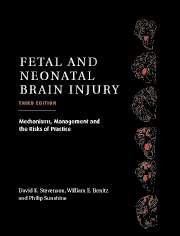Book contents
- Frontmatter
- Contents
- List of contributors
- Foreword
- Preface
- Part I Epidemiology, Pathophysiology, and Pathogenesis of Fetal and Neonatal Brain Injury
- Part II Pregnancy, Labor, and Delivery Complications Causing Brain Injury
- Part III Diagnosis of the Infant with Asphyxia
- Part IV Specific Conditions Associated with Fetal and Neonatal Brain Injury
- 26 Hypoglycemia in the neonate
- 27 Hyperbilirubinemia and kernicterus
- 28 Polycythemia
- 29 Hydrops fetalis
- 30 Acidosis/alkalosis
- 31 Meconium staining and the meconium aspiration syndrome
- 32 Persistent pulmonary hypertension of the newborn
- 33 Pediatric cardiac surgery: relevance to fetal and neonatal brain injury
- Part V Management of the Depressed or Neurologically Dysfunctional Neonate
- Part VI Assessing the Outcome of the Asphyxiated Infant
- Index
- Plate section
32 - Persistent pulmonary hypertension of the newborn
from Part IV - Specific Conditions Associated with Fetal and Neonatal Brain Injury
Published online by Cambridge University Press: 10 November 2010
- Frontmatter
- Contents
- List of contributors
- Foreword
- Preface
- Part I Epidemiology, Pathophysiology, and Pathogenesis of Fetal and Neonatal Brain Injury
- Part II Pregnancy, Labor, and Delivery Complications Causing Brain Injury
- Part III Diagnosis of the Infant with Asphyxia
- Part IV Specific Conditions Associated with Fetal and Neonatal Brain Injury
- 26 Hypoglycemia in the neonate
- 27 Hyperbilirubinemia and kernicterus
- 28 Polycythemia
- 29 Hydrops fetalis
- 30 Acidosis/alkalosis
- 31 Meconium staining and the meconium aspiration syndrome
- 32 Persistent pulmonary hypertension of the newborn
- 33 Pediatric cardiac surgery: relevance to fetal and neonatal brain injury
- Part V Management of the Depressed or Neurologically Dysfunctional Neonate
- Part VI Assessing the Outcome of the Asphyxiated Infant
- Index
- Plate section
Summary
Persistent pulmonary hypertension of the newborn (PPHN) is characterized by markedly elevated pulmonary vascular resistance and pulmonary arterial pressure, along with striking pulmonary vasoreactivity, which produces right-to-left shunting through the ductus arteriosus and foramen ovale. With severe PPHN, this extrapulmonary shunting results in severe hypoxemia, which typically is poorly responsive to treatment with high concentrations of inspired oxygen, assisted ventilation, and pharmacologic manipulation of the circulation. Elevated pulmonary vascular resistance with right-to-left extrapulmonary shunting also often occurs in association with severe pulmonary parenchymal disease, including meconium aspiration syndrome, bacterial pneumonia, lung hypoplasia, or hyaline membrane disease, and may be compounded by coexistent impairment of systemic cardiac output and/or systemic arterial pressures due to impaired myocardial function, hypovolemia, or systemic vasodilation. In addition, pulmonary hypertension is often very difficult to distinguish from total anomalous pulmonary venous return, and may complicate a variety of other congenital cardiac malformations. These associated conditions may occur with or without intrinsic structural and functional abnormalities of the pulmonary vascular bed, and treatment needs not only to be specific for the underlying or associated conditions, but also must account for the expected normal or abnormal behavior of the pulmonary blood vessels. As a consequence, infants with pulmonary hypertension present one of the most difficult diagnostic and therapeutic challenges in neonatal intensive care.
- Type
- Chapter
- Information
- Fetal and Neonatal Brain InjuryMechanisms, Management and the Risks of Practice, pp. 636 - 662Publisher: Cambridge University PressPrint publication year: 2003



